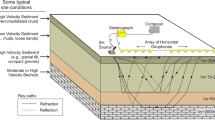Abstract
In this paper, we derive an approximation of the SS-wave reflection coefficient and the expression of S-wave ray elastic impedance (SREI) in terms of the ray parameter. The SREI can be expressed by the S-wave incidence angle or P-wave reflection angle, referred to as SREIS and SREIP, respectively. Our study using elastic models derived from real log measurements shows that SREIP has better capability for lithology and fluid discrimination than SREIS and conventional S-wave elastic impedance (SEI). We evaluate the SREIP feasibility using 25 groups of samples from Castagna and Smith (1994). Each sample group is constructed by using shale, brine-sand, and gas-sand. Theoretical evaluation also indicates that SREIP at large incident angles is more sensitive to fluid than conventional fluid indicators. Real seismic data application also shows that SREIP at large angles calculated using P-wave and S-wave impedance can efficiently characterize tight gas-sand.
Similar content being viewed by others
References
Aki, K., and Richards, P. G., 1980, Quantitative seismology: theory and methods: W. H. Freeman and Company, New York.
Avseth, P., Mukerji, T., and Mavko, G., 2005, Quantitative seismic interpretation: applying rock physics tools to reduce interpretation risk: Cambridge University Press, England.
Castagna, J. P., and Smith, S. W., 1994, Comparison of AVO indicators: A modeling study: Geophysics, 59(12), 1849–1855.
Connolly, P., 1999, Elastic impedance: The Leading Edge, 18(4), 438–452.
Duffaut, K., Alsos, T., Landre, M., Rognø, H., and Al-Najjar, N. F., 2000, Shear-wave elastic impedance: The leading Edge, 19, 1223–1229.
Foster, D. J., Keys, R. G., and Lane, F. D., 2010, Interpretation of AVO anomalies: Geophysics, 75, A3–A13.
Goodway, W., Chen, T., and Downton, J., 1997, Improved AVO fluid detection and lithology discrimination using Lamé petrophysical parameters from P and S inversion: 67th Ann. Internat. Mtg., Soc. Expl. Geophys., Expanded Abstracts, 183–186.
Jiang, W., Li, L., and Zhao, J., 2010, Application of fluid identification with multi-parameter cross-plotting: Progress in Exploration Geophysics, 33(3), 189–195.
Li, X., and Zhang, Y., 2011, Seismic reservoir characterization: how can multicomponent data help?: Journal of Geophysics and Engineering, 8, 123–141.
Ma, J., 2003, Forward modeling and inversion methods based on generalized elastic impedance in seismic exploration: Journal of Chinese Geophysics, 46, 159–168.
Ma, J.F., and Morozov, I. B., 2007, The exact elastic impedance for P-SV wave: 77th Ann. Internat. Mtg., Soc. Explor. Geophys., Expanded Abstracts, 288–292.
Smith, G. C., and Gidlow, P. M., 1987, Weighted stacking for rock property estimation and detection of gas: Geophysical Prospecting, 35, 993–1014.
VerWest, B., 2004, Elastic impedance revisited: 66th EAGE Conference and Exhibition, Extended Abstracts, P342.
Wang, Y., 1999, Approximations to the Zoeppritz equations and their use in AVO analysis: Geophysics, 64, 1920–1927.
Wang, Y., 2003, Seismic amplitude inversion in reflection tomography: Elsevier Science.
Yin, C., and Gu, H., 2008, The sensitivity analysis of AVO fluid factors: Chinese Journal of Engineering Geophysics, 5(1), 85–88.
Zhang, F., Wang, Y., and Li, X., 2012, Viabilities of seismic ray impedance and elastic impedance for hydrocarbonsand discrimination: Geophysics, 77(4), M39–M52.
Zheng, X., 1991, Relationships between converted and nonconverted waves and parameter p: Chinese Journal of Geophysics, 34(6), 781–787.
Zhou, Y., and Li, X., 2010, Application of sensitive angle elastic impedance in fluid prediction: OGP, 45(5), 710–713.
Author information
Authors and Affiliations
Corresponding author
Additional information
This study is sponsored by National Natural Science Fund Projects (No.41204072 and No.U1262208), Research Funds Provided to New Recruitments of China University of Petroleum-Beijing (YJRC-2011-03), and Science Foundation of China University of Petroleum-Beijing (YJRC-2013-36).
Gong Xue-Ping graduated from China University of Petroleum (Beijing) with a Bachelor’s Degree in Information and Computation Science in 2007. She is now a PhD student at China University of Petroleum (Beijing) majoring in Geo-resources and Geo-engineering. Her research direction is seismic inversion and interpretation.
Rights and permissions
About this article
Cite this article
Gong, XP., Zhang, F., Li, XY. et al. Study of S-wave ray elastic impedance for identifying lithology and fluid. Appl. Geophys. 10, 145–156 (2013). https://doi.org/10.1007/s11770-013-0372-6
Received:
Revised:
Published:
Issue Date:
DOI: https://doi.org/10.1007/s11770-013-0372-6




